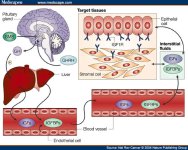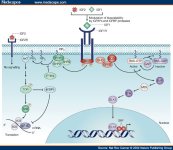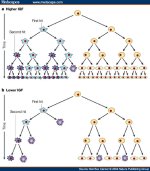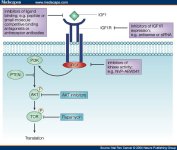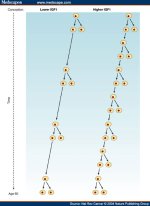IGF-1 & MGF timing
Thanks DAT.
So, just to make sure I'm clear, PEG-MGF should be used to promote the myotube formation stimulated by the expression of IGF-1Ea approx. 2 days after a particular muscle group is damaged / exercised? In other words, if you hit your chest two days ago, the PEG-MGF administration today will assist in myotube formation of the chest muscles? Also, this process will last around 4 hours or so?
I don't know.
Its okay not to know.

I was researching Fibroblast growth factor (FGF). There are several forms. One form seems to be capable of acting in the same manner as Mechano Growth Factor (MGF).
The advantage of FGF would be that unlike MGF, there are receptors for it so exogenously administered peptide could bind to a cell and effect proliferation.
Anyway the key point was that proliferation and differentiation are two sides of the same coin. To stop proliferation you induce differentiation. To promote proliferation you arrest differentiation.
This seems to be the case for all cells. For instance fat cells proliferate. But Octanoate stops proliferation by inducing differentiation. Thus a reduction in visceral fat (given the correct accompanying protocol)
So if we keep this in mind and look at muscle we want to induce proliferation for as long as possible before inducing differentiation. Why? Because if you differentiate too early you have ended the potential to early.
In one study they used FGF to proliferate a cell and they were able to do this for 100+ straight days.
What are we talking about? Lets look at an abstract that looks at these growth factors.
Regulation of skeletal muscle satellite cell proliferation and differentiation by transforming growth factor-beta, insulin-like growth factor I, and fibroblast growth factor,
Ronald E. Allen,
Journal of Cellular Physiology 1988 Volume 138 Issue 2, Pages 311 - 315
Abstract:
Skeletal muscle satellite cells were cultured from mature rats and were treated in vitro with various combinations of transforming growth factor (TGF)-beta, fibroblast growth factor (FGF), and insulin-like growth factor I (IGF-I). In serum-free defined medium the following observations were made:
- TGF-beta depressed proliferation and inhibited differentiation;
- FGF stimulated proliferation and depressed differentiation;
- IGF-I stimulated proliferation to a small degree but demonstrated a more pronounced stimulation of differentiation.
In evaluating combinations of these three factors, the differentiation inhibiting effect of TGF-beta could not be counteracted by any combination of IGF-I or FGF. The proliferation-depressing activity of TGF-beta, however, could not inhibit the
mitogenic activity of FGF.
Maximum stimulation of proliferation was observed in the presence of both FGF and IGF-I. The highest percentage fusion was also observed under these conditions, but
differentiation with minimal proliferation resulted from treatment with IGF-I, alone. By altering the concentrations of TGF-beta, FGF, and IGF-I, satellite cells can be induced to proliferate, differentiate, or to remain quiescent.
So while all of this is interesting it does not specifically tell bodybuilders how to do things.
Lets see if there is anything we can pull from this.
IGF-1 (if there is no other proliferating growth factor active (such as MGF or FGF) is capable of mild proliferation but strong differentiation activity.
Does IGF-1 interfere with MGF?
From the full study which gives a more complete picture then the abstract:
"FGF was apparently unable to inhibit differentiation at this cell density in the presence of IGF-I."
The presence of TGF-beta was required before the FGF & IGF-1 combo resulted in proliferation instead of differentiation. TGF-beta is present naturally at the time of injury, but "if the TGF-beta that is released from platelets immediately following injury is depleted, leaving only IGF and possibly FGF, satellite cells could be expected to differentiate into myotubes" rather then proliferate.
IF MGF behaves as FGF, then from the study it is only the presence of TGF-beta that would allow MGF to continue proliferating in the presence of IGF-1. When TGF-beta is depleted at the site, then the presence of IGF-1 will override MGF's proliferation activity and instead differentiation will occur.
What I have always been concerned about was IGF-1 stopping MGFs actions. A full read of the study indicates that this is probably a legitimate concern.
So on a practical level it actually may be better to avoid administering IGF-1 (or IGF-1 masquerading as peg-MGF) in the environment where your body creates & utilizes MGF...that is post-weightlifting.
I had been thinking about this IGF-1 LR3 timing before and had thought that post-workout might not be the best time to administer it. This study gives some validity to my previous thoughts.
So how long to wait?
I don't know. Beyond two days would be overkill.
Maybe larger doses of IGF-1 more infrequently is the way to go.
If not perhaps at least waiting till the next day post-workout to administer IGF-1 LR3 is a practical way to go.
One other thought occurs. Perhaps people (myself included in the past) realized very little from IGF-1 LR3
because it was administered post-workout. Perhaps this is the worst time or at least a waste of time, to administer IGF-1 LR3.
And since I am throwing out a bunch of maybes, here's one more...
Maybe Peg-MGF (which acts as IGF-1) is partially more effective anecdotally because people are not administering post-workout.





















































